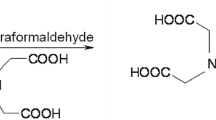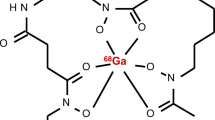Abstract
Purpose
The present work was aimed at the development of prospective positron emission tomography (PET) agents for infection imaging. Towards this aim, ubiquicidin (UBI) fragments conjugated with the macrocyclic NODAGA chelator were radiolabeled with Ga-68 and evaluated.
Procedures
Conformations of custom synthesized NODAGA-UBI (29–41) and NODAGA-UBI (31–38) conjugates were compared with UBI (29–41) by circular dichroism (CD) spectroscopy. Optimization of labeling of NODAGA conjugates of UBI peptides with Ga-68 was performed and quality control analysis was carried out by chromatography techniques. In vitro uptake of [68Ga] NODAGA-UBI (29–41) and [68Ga]NODAGA-UBI (31–38) was studied in Staphylococcus aureus cells. In vivo distribution of [68Ga]GaCl3 and [68Ga]NODAGA-UBI complexes was performed in normal Swiss mice.
Results
Conformations of NODAGA-UBI (29–41) and NODAGA-UBI (31–38) conjugates were found to be similar to UBI (29–41). NODAGA-UBI conjugates could be consistently labeled with Ga-68 in high radiochemical yields (>95 %) with high radiochemical purity (>95 %). [68Ga]NODAGA-UBI (29–41) and [68Ga]NODAGA-UBI (31–38) complexes showed retention time of 14 and 14.5 min, respectively, by HPLC radiochromatogram. Specific uptake of [68Ga]NODAGA-UBI fragments was observed in S.aureus cells. Greater than 64 % of the injected dose was cleared via the renal route at 1 h post injection, and no significant uptake in vital organs of mice was observed with both the agents.
Conclusion
This is the first report on Ga-68 labeled NODAGA-UBI fragments for infection imaging and the agents hold tremendous prospect in PET imaging.







Similar content being viewed by others
References
Palestro CJ (2009) Radionuclide imaging of infection: in search of the grail. J Nucl Med 50:671–673
Boerman OC, Dams ET, Oyen WJ et al (2001) Radiopharmaceuticals for scintigraphic imaging of infection and inflammation. Inflamm Res 50:55
Petruzzi N, Shanthly N, Thakur M (2009) Recent trends in soft tissue infection imaging. Semin Nucl Med 39(2):115–123
Goldsmith SJ, Vallabhajosula S (2009) Clinically proven radiopharmaceuticals for infection imaging: mechanisms and applications. Semin Nucl Med 39:2–10
Glaudemans AWJM, Signore A (2010) FDG-PET/CT in infections: the imaging method of choice? Eur J Nucl Med Mol Imaging 37:1986–1991
Pellegrino D, Bonab AA, Dragotakes SC et al (2005) Inflammation and infection: imaging properties of 18F-FDG-labeled white blood cells versus 18F-FDG. J Nucl Med 46:1522–1530
Anderson CJ, Ferdani R (2009) Copper-64 radiopharmaceuticals for PET imaging of cancer: advances in preclinical and clinical research. Cancer Biother Radiopharm 24:379–393
Nayak TK, Brechbiel MW (2011) 86Y based pet radiopharmaceuticals: radiochemistry and biological applications. Med Chem 7:380–388
Fischer G, Seibold U, Schirrmacher R et al (2013) 89Zr, a radiometal nuclide with high potential for molecular imaging with PET: chemistry, applications and remaining challenges. Molecules 18:6469–6490
Röesch F, Riss PJ (2010) The renaissance of the 68Ge/68Ga radionuclide generator initiates new developments in 68Ga radiopharmaceutical chemistry. Curr Top Med Chem 10:1633–1668
Decristoforo C (2012) Gallium-68—a new opportunity for PET available from a long shelf life generator—automation and applications. Curr Radiopharm 5:212–220
Velikyan I (2014) Prospective of 68Ga-radiopharmaceutical development. Theranostics 4:47–80
Mukherjee A, Pandey U, Chakravarty R et al (2014) Development of single vial kits for preparation of 68Ga labeled peptides for PET imaging of neuroendocrine tumors. Mol Imag Biol 16:550–557
Price EW, Orvig C (2014) Matching chelators to radiometals for radiopharmaceuticals. Chem Soc Rev 43:260–290
Ferreira CL, Lamsa E, Woods M et al (2010) Evaluation of bifunctional chelates for the development of gallium-based radiopharmaceuticals. Bioconjug Chem 21:531–536
Correia JDG, Paulo A, Raposinho PD, Santos I (2011) Radiometallated peptides for molecular imaging and targeted therapy. Dalton Trans 40:6144–6167
Nibbering PH, Welling M, Den Broek V, Pauwels EKJ (1998) Radiolabelled antimicrobial peptides for imaging of infections: a review. Nucl Med Commun 19:1117–1121
Murphy CA, Gemmel F, Balter J (2010) Clinical trial of specific imaging of infections. Nucl Med Commun 31:726–733
Sepulveda-Mendez J, de Murphy CA, Rojas-Bautista JC, Pedraza-Lopez M (2010) Specificity of 99mTc-UBI for detecting infection foci in patients with fever in study. Nucl Med Commun 31:889–895
Gemmel F, Dumarey N, Welling M (2009) Future diagnostic agents. Semin Nucl Med 39:11–26
Tollin M, Bergman P, Svenberg T et al (2003) Antimicrobial peptides in the first line defence of human colon mucosa. Peptides 24:523–530
Hiemstra PS, van der Barselaar MT, Roest M et al (1999) Ubiquicidin, a novel murine microbicidal protein present in cytosolic fraction of macrophages. Leukoc Biol 66:423–428
Welling MM, Paulusma-Annema A, Balter HS et al (2000) Technetium-99m labelled antimicrobial peptides discriminate between bacterial infections and sterile inflammations. Eur J Nucl Med 27:292–301
Brouwer CPJM, Bogaards SJP, Wulferink M et al (2006) Synthetic peptides derived from human antimicrobial peptide ubiquicidin accumulate at sites of infections and eradicate (multi-drug resistant) Staphylococcus aureus in mice. Peptides 27:2585–2591
Arjun C, Mukherjee A, Bhatt J et al (2016) Studies on batch formulation of a kit for the preparation of the 99mTc-ubiquicidin (29-41): an infection imaging agent. Appl Rad Isot 107:8–12
Nibbering PH, Welling MM, Paulusma-Annema A et al (2004) Tc-99m-labeled UBI 29-41 peptide for monitoring the efficacy of antibacterial agents in mice infected with Staphylococcus aureus. J Nucl Med 45:321–326
Welling MM, Lupetti A, Balter HS et al (2001) 99mTc-labeled antimicrobial peptides for detection of bacterial and Candida albicans infections. J Nucl Med 42:788–794
Sarda-Mantel L, Saleh-Mghir A, Welling MM et al (2007) Evaluation of (99m) Tc-UBI 29-41 scintigraphy for specific detection of experimental Staphylococcus aureus prosthetic joint infections. Eur J Nucl Med Mol Imag 34:1302–1309
Ferro-Flores G, de Murphy CA, Pedraza-Lopez M et al (2003) In vitro and in vivo assessment of Tc-99m-UBI specificity for bacteria. Nucl Med Biol 30:597–603
Ostovar A, Assadi M, Vahdat K et al (2013) A pooled analysis of diagnostic value of (99m)Tc ubiquicidin (UBI) scintigraphy in detection of an infectious process. Clin Nucl Med 38:413–416
Kubicek V, Havlickova J, Kotek J et al (2012) Synthesis of 68Ga-NOTA-UBI30-41 and in vivo biodistribution in vervet monkeys towards potential PET/CT imaging of infection. J Nucl Med 53:1520
Ebenhan T, Zeevaart JR, Venter JD et al (2014) Preclinical evaluation of 68Ga-labeled 1, 4, 7-triazacyclononane-1, 4, 7-triacetic acid-ubiquicidin as a radioligand for PET infection imaging. J Nucl Med 55:1–7
Ebenhan T, Chadwick N, Sathekge MM et al (2014) Peptide synthesis, characterization and 68Ga-radiolabeling of NOTA-conjugated ubiquicidin fragments for prospective infection imaging with PET/CT. Nucl Med Biol 41:390–400
Akhtar MS, Imran MB, Nadeem MA, Shahid A (2012) Antimicrobial peptides as infection imaging agents: better than radiolabeled antibiotics. Int J Pept : Article ID 965238,doi:10.1155/2012/965238
Appelboom T, Emery P, Tant L et al (2003) Evaluation of technetium-99m-ciprofloxacin (infection) for detecting sites of inflammation in arthritis. Rheumatology 42:1179–1182
Strand J, Honarvar H, Perols A et al (2013) Influence of macrocyclic chelators on the targeting properties of 68Ga-labeled synthetic affibody molecules: comparison with 111In-labeled counterparts. PLoS One 8:e70028
Knetsch PA, Petrik M, Griessinger CM et al (2011) [68Ga]NODAGA-RGD for imaging alphavbeta3 integrin expression. Eur J Nucl Med Mol Imaging 38:1303–1312
Oxboel J, Brandt-Larsen M, Schjoeth-Eskesen C et al (2014) Comparison of two new angiogenesis PET Tracers 68Ga-NODAGA-E[c(RGDyK)]2 and 64Cu-NODAGA-E[c(RGDyK)]2; in vivo imaging studies in human xenograft tumors. Nucl Med Biol 41:259–267
Pohle K, Notni J, Bussemer J et al (2012) 68Ga-NODAGA-RGD is a suitable substitute for 18F-Galacto-RGD and can be produced with high specific activity in a cGMP/GRP compliant automated process. Nucl Med Biol 39:777–784
Yeaman MR, Yount NY (2003) Mechanisms of antimicrobial peptide action and resistance. Pharmacol Rev 55:27–55
Sani MA, Henriques ST, Weber D, Separovic F (2015) Bacteria may cope differently from similar membrane damage caused by the Australian tree frog antimicrobial peptide maculatin. J Biol Chem 290:19853–19862
Acknowledgments
Research at the Bhabha Atomic Research Centre (BARC) is part of the ongoing activities of the Department of Atomic Energy, India, and it is fully supported by government funding. The authors express their sincere thanks to Dr. K.L. Ramakumar, Group Director, RC& I Group, BARC for his encouragement and support.
Author information
Authors and Affiliations
Corresponding author
Ethics declarations
All animal experiments were carried out as per guidelines, regulations, and approval from the local animal ethics committee.
Conflict of Interest
The authors declare that they have no conflict of interest.
Rights and permissions
About this article
Cite this article
Bhatt, J., Mukherjee, A., Korde, A. et al. Radiolabeling and Preliminary Evaluation of Ga-68 Labeled NODAGA-Ubiquicidin Fragments for Prospective Infection Imaging. Mol Imaging Biol 19, 59–67 (2017). https://doi.org/10.1007/s11307-016-0983-4
Published:
Issue Date:
DOI: https://doi.org/10.1007/s11307-016-0983-4




